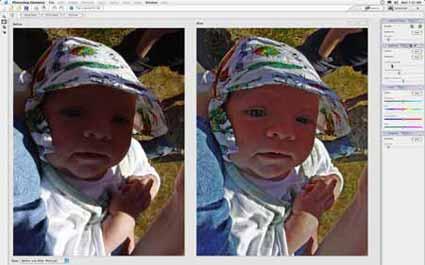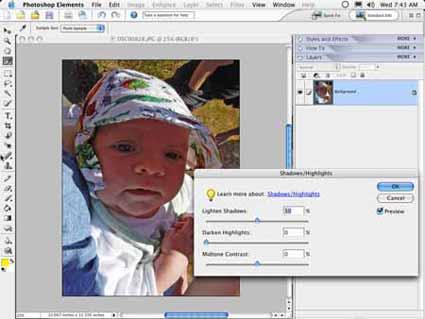Posted Wednesday, September 15, 2004
Looking at Photoshop Elements 3
Today, Adobe announced a new version of Photoshop Elements 3, its version of Photoshop for the rest of us. Elements 3 is a great upgrade that borrows some of the best new features from Photoshop 7 and Photoshop CS, while at the same time making the entire image editing process easier and more approachable for people who aren't digital imaging gurus.
Here's a preview.
Out of the Shadows
Most noteworthy is a shadow/highlight recovery feature that, like its Photoshop CS counterpart, does an amazing job of bringing out details hidden in dark shadows and bright highlights.
In Elements 3, Adobe has also refined the Quick Fix mode, placing key sliders along the right hand side of the screen (click the screen below to see a larger version).

You can also access the shadow/highlight recovery feature from Elements' standard editing mode, which shows off additional user interface changes. The tool palette along the left side of the screen is now resizable, and the Layers, How-To, and Styles and Effects palettes are now collapsable. (You can also undock them and turn them into floating palettes.)

See Spot Heal
Also noteworthy is Elements 3's new set of healing brush tools. The healing brush first debuted in Photoshop 7, and Elements takes it one step further with the spot healing brush.
Like the retouch tool in iPhoto, the spot healing brush doesn't require you to specify a source point before you use it. Simply point to a flaw and then click and drag. The standard healing brush (which does use a source point) is also available.
Let's Get Raw
Photoshop Elements 3 also includes support for Camera Raw images. That's a first for Elements, and it's a welcome addition, now that more and more advanced amateurs are embracing the raw format.
The version of Camera Raw included with Elements 3 lacks some of the capabilities of its Photoshop CS counterpart. For example, the Lens and Calibrate tabs aren't present, which means you can't fix chromatic aberration and vignetting, nor can you create a custom calibration for a specific device. Also, the Elements 3 version of Camera Raw doesn't have the impressive "up-rezing" features of its Photoshop CS big sister, nor does it let you choose a color space for the image (click the screen below to see a larger version).

But still -- having raw format support in an $89 program is a good thing.
It's No Shoebox
If you browse the pages for the Windows version of Photoshop Elements, you'll notice it has a feature the Mac version lacks: photo cataloging. Adobe has rolled many of the features of its Photoshop Album software into the Windows version of Elements 3. But it left these features out of the Mac version, and for a good reason: we Mac users have iPhoto for cataloging.
Happily, the new Elements 3 also coexists beautifully with iPhoto. You can use iPhoto's preferences command to have iPhoto launch Elements 3 when you double-click an image in your photo library. And as I describe on page 111 of The Macintosh iLife '04, you can also simply drag a photo from your iPhoto library onto the Elements icon in your dock.
There's more to Elements 3, and I'll have more to say later. In the meantime, Mac shutterbugs have a lot to look forward to when the new version ships.
Master the elements of iLife. The Macintosh iLife '04 is the only computer book of its kind: a gorgeous, full-color guide to all five iLife programs, plus a companion two-hour instructional DVD that's also packed with GarageBand loops, example files, software, and more. (Check out the excerpts.) All for a price even the author thinks is too low: $20.99 on Amazon.com.